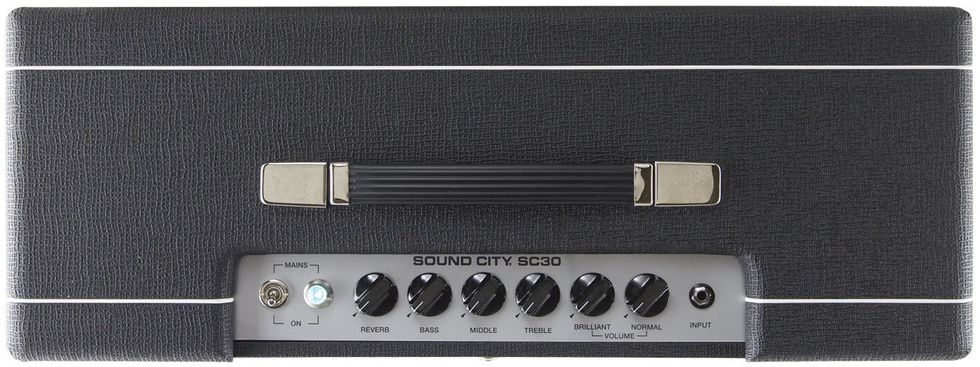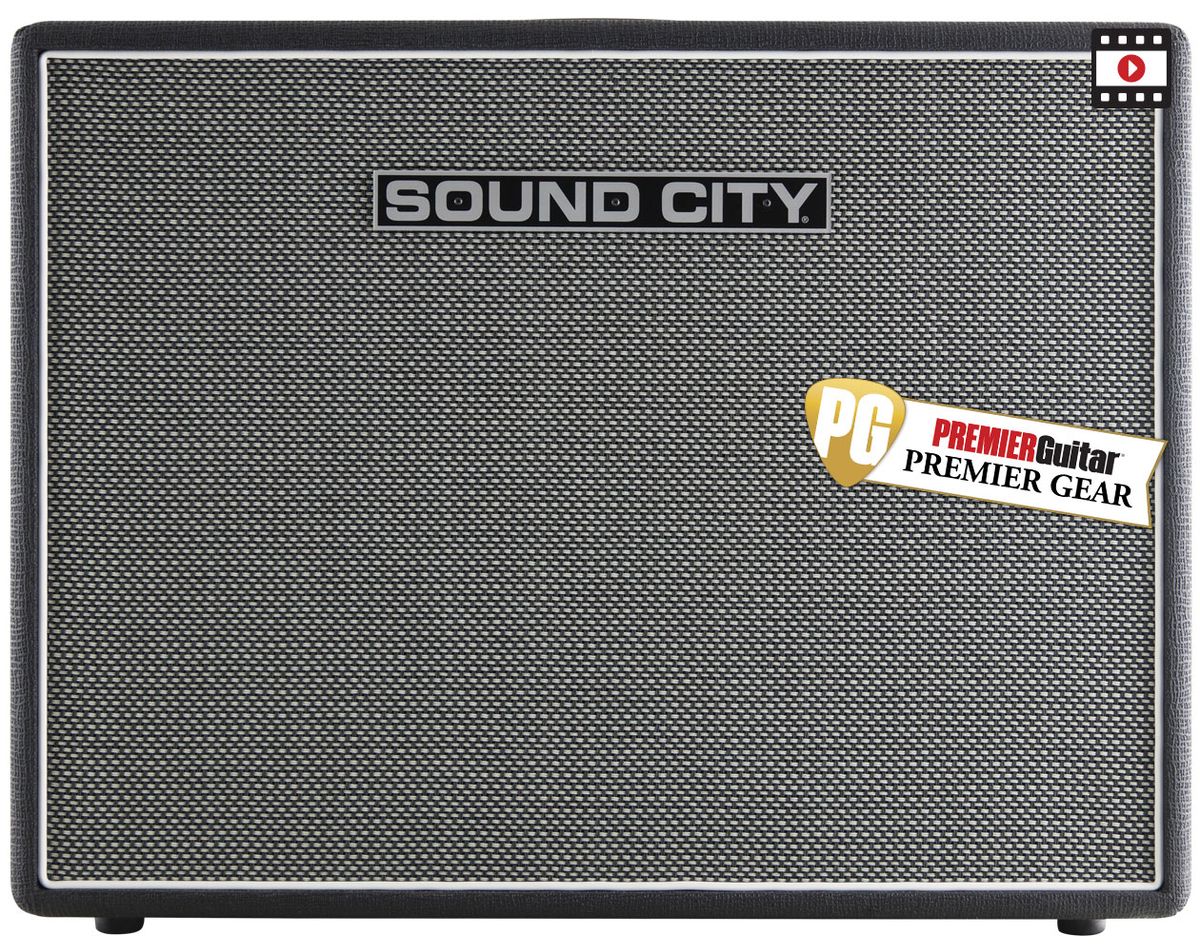This ’60s-inspired combo is a minimalist monster.
RatingsPros:Superb and distinctive tones. Vast tonal range via simple controls. Extraordinary dynamic response. Quality build. Cons: No master volume. Street: $2,395 Sound City SC30 soundcityamp.com | Tones: Ease of Use: Build/Design: Value: |
When I was starting out on guitar a few too many decades ago, I’d sometimes spot used Sound City amps in guitar shops—and run the other way. It was solid-state crap—just the sort of stuff a shifty salesperson would try to unload on an ignorant kid.
And I was an ignorant kid. I had no idea that Sound City had made cool amps in the 1960s. Those original amps were created for and named after Ivor Arbiter’s London music shop. Playing catch-up with fellow retailer Jim Marshall and his bold new amps, Arbiter hired Dave Reeves to design competitive models. But not long after, Reeves moved on to create the historic Hiwatt brand, while Sound City amps slid into mediocrity.
Second Sound City
Last year Steve Fryette and Neal Ostberg of Fryette Amplification acquired the Sound City name. The 30-watt 1x12 SC30 combo is their latest effort. It’s not based on a particular vintage model, but it definitely provides a mid-1960s playing experience, with an emphasis on power tube distortion. The SC30 doesn’t sound quite like an old Marshall JTM45, but anyone who digs “Bluesbreaker”-style amps should feel right at home here.
The ’60s amps that inspire the new Sound City line have separate bright and normal channels. Here, though, there’s a single input, with separate controls for the internally jumpered channels. There are bass, mid, and treble controls, plus a wet/dry knob for the amp’s juicy spring reverb. That’s it—pretty darn simple.
Nonetheless, the SC30 provides a phenomenal range of tones. Its clean colors balance formidable low-end girth and airy sparkle. They’re hyper-articulate, transmitting every dynamic variation, every brush of fingernail or scrape of pick. Nuanced players will love these nuanced sounds.
Tones get crunchy when you raise the two volume controls toward their midpoints. You can summon many shades of distortion by adjusting the relative brilliant/normal levels. At high volume, tones are massive, with glorious power-amp saturation and seemingly eternal sustain. Yet even with the volume knobs cranked, tones retain powerful upper-mid presence and snappy response. These sounds aren’t tight in the modern hard-rock/metal sense, but they get closer to that sensibility than many ’60s-style combos.
Roar, Not Buzz
The lack of a master volume control is a double-edged sword. It means you’re working with rich power-tube distortion, not buzzy preamp gain. But it can be hard to access low-volume crunch without adding a power attenuator or load box. The SC30 is loud for a 30-watt amp, and it sounds so good when it’s working hard that you’ll probably want to let it. This is a hot amp in every sense—you can feel the heat coming off the chassis. (The power tubes are cathode bias, which results in higher operating temperature).
The tone controls feel … curated, for lack of a better word. Their ranges aren’t vast, but their usefulness is. High bass settings provide extraordinary wallop for an open-back combo. High treble settings are bright but not sadistically shrill. With both gain and treble cranked, you get vicious, glassy crunch that maintains its musicality. The SC30 excels at the brutal-in-a-cool-way sizzle you get from, say, overdriven Tele bridge pickups. (I give the tone controls a workout starting at 06:55 in the demo clip. I play a series of similar riffs on a single humbucker bridge pickup, changing nothing but the tone knob settings.) In short, SC30 merits that highest of amp accolades: “It’s impossible to dial in a bad sound.”
Valve Job
Some of the SC30’s character stems from its dual KT66 power tubes. (You can substitute 6L6s or 5881s without re-biasing, though I didn’t test these options.) Compared to, say, the EL34 tubes found in many Marshall amps, KT66s are slower to distort. Their highs have more chime, and their lows have more punchy definition. It’s a hi-fi sound relative to, say, the grinding, midrange-forward character of plexi-era Marshalls.

The SC30’s relatively high headroom and wide frequency range should please players who tend to sculpt tones from their pedalboards. But it’s not as if you need stompboxes to make the most of this amp—especially given its remarkable dynamic response. You can veer from vicious to crystalline using only your guitar’s volume knob. I’d have no qualms about gigging with nothing more than a guitar, the SC30, and a cable. Well, maybe a beer.
The warm-toned, 3-spring Accutronics reverb tank isn’t too strongly flavored. There are no pesky resonant peaks. It does nice surfy/splashy sounds, while modest settings complement the amp’s assertive, ultra-present character.
Board Stiff
Peek inside the SC30’s chassis and you may be surprised by how … normal it looks. Small components are arrayed on one large circuit board plus three subsidiary boards. Heavy-duty standoffs secure these thick boards, and none of the amp’s potsor jacks are board-mounted. Circuit board construction keeps costs down, and Fryette reinvests where it matters most sonically: the custom speaker and transformers and the glorious-sounding Gold Lion power tubes.
The solid-wood cabinet feels reliable. The vinyl covering and grille fabric are handsome. The amp’s compact dimensions (approximately 24.5" x 19" x 9") mean easy storage and transportation, but at 48 pounds, this may not be a great choice for the hernia prone.
The Verdict
The SC30 is a minimalist monster. The controls are simple. Bells and whistles are conspicuous in their absence. There’s no effects loop, no channel switching, no footswitch control—not even a standby switch. Nevertheless, you get a huge range of tactile tones distinguished by crisp presence, rich overtones, and superb dynamic response. The use of circuit board construction in this price range may disappoint some players, though I suspect any misgivings will evaporate about 10 seconds after plugging in. I adore this bold and versatile amp.
Watch the Review Demo:


